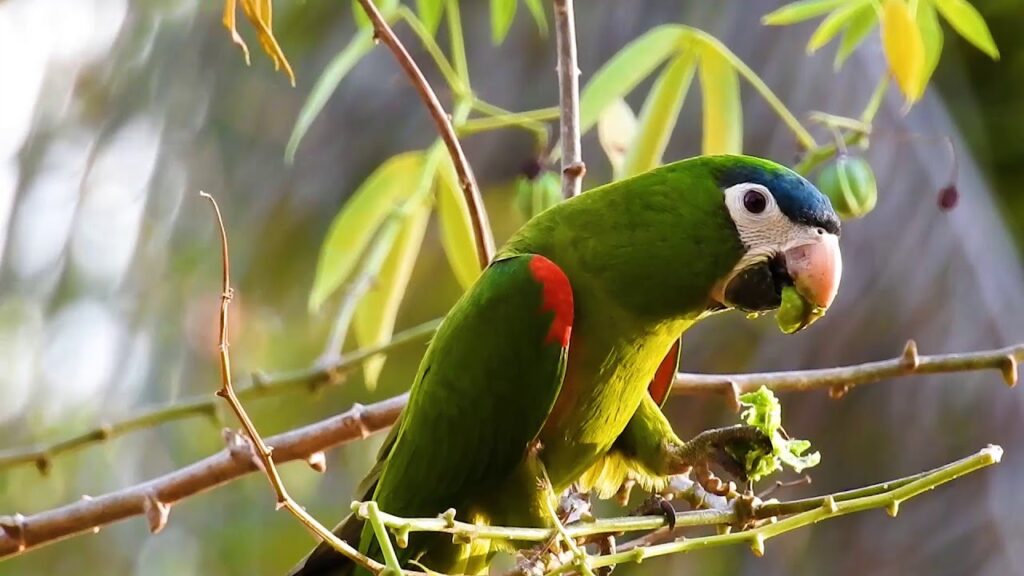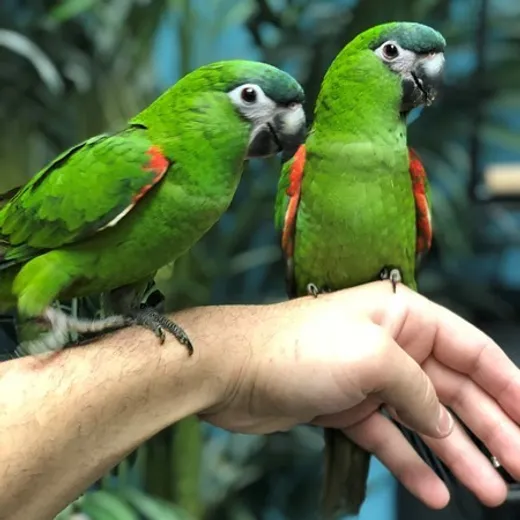Unveiling the Charms of Hahn’s Macaw: Your Miniature Marvel in the Parrot World
Hahn’s macaws stand as the epitome of charm and popularity among miniature macaws, captivating hearts far and wide. Their petite yet spirited demeanor has cemented their status as exceptional companions that forge unwavering connections with their human counterparts. Beyond their diminutive size lies a world of intelligence, with the potential to master tricks and behaviors, and even hold conversations. If you yearn for the grandeur of a macaw but lack the space for their larger counterparts, Hahn’s macaws offer the perfect solution.
Species Overview: Discovering the Majesty
COMMON NAMES: Hahn’s macaw, red-shouldered macaw
SCIENTIFIC NAME: Diopsittaca nobilis nobilis (formerly Ara nobilis nobilis)
ADULT SIZE: 12 inches, 5 ounces
LIFE EXPECTANCY: 20 to 30 years
Origin and History: Tracing the Roots
Hahn’s macaw represents one of the two variations of red-shouldered macaws, its counterpart being the noble macaw (Ara nobilis cumanensis). Both these splendid species originate from the northern realms of South America. A tribute to the German zoologist Carl-Wilhelm Hahn, these macaws bear his name due to his meticulous documentation and portrayal of New World avian wonders.
Inhabitants of Brazil, Guyana, and Venezuela, these avian gems predominantly dwell in tropical lowlands, occasionally favoring savannas and swamplands. In their natural habitat, Hahn’s macaws create tight-knit flocks, harmonizing with the vibrant foliage that envelops them.
Temperament: The Essence of Vibrance
Radiating intelligence and allure, Hahn’s macaws shine as popular companions. However, beneath their compact form resides a personality that matches their larger counterparts in charisma. Brace yourself for a medley of lively displays as they weave hours of entertainment.

With a size ideal for cozy spaces and a disposition friendly towards children, these avian wonders complement urban living—save for apartment settings, where their penchant for occasional outbursts of exuberance could lead to quite the commotion.
Their inherently gentle nature becomes evident with maturity, even more so when properly acclimated. A well-socialized Hahn’s macaw grows into a delightful companion, fostering harmonious interactions with children and adults alike.
Speech and Vocalizations: The Eloquent Artists
Within the realm of avian eloquence, Hahn’s macaws stand out as articulate conversationalists. Through diligent training, both males and females craft a repertoire of words and phrases, delivered in a melodious yet distinct pitch. However, akin to their larger counterparts, these miniature marvels are also capable of producing boisterous calls, and if kept as a pair, the symphony doubles in intensity, often heralding the sunrise.
Hahn’s Macaw Colors and Markings: Nature’s Masterpiece
The mature Hahn’s macaw adorns itself in verdant hues, with a deep greenish-blue crown gracing its forehead. A splash of vivid red graces the wing undersides, earning it the moniker “red-shouldered macaw.”
Black hues dominate the beak, contrasted elegantly by the upper beak’s beige to white gradient. The eyes, a captivating burnt orange, are encircled by the trademark white eye-rings.
Remarkably agile with their slightly oversized black feet, these macaws exhibit a unique toe arrangement facilitating climbing and manipulation of objects. Sexing them visually is impossible, necessitating genetic or surgical methods.
Often confused with noble macaws, Hahn’s macaws assert their distinction through size, with the former boasting a beige beak. For those acquainted with sun conures, Hahn’s macaws share similar dimensions.
Nurturing the Hahn’s Macaw: A Bond Beyond Compare
Mirroring their larger kin, Hahn’s macaws echo the same requisites of companionship—social engagement, balanced nutrition, and ample exercise. Delve into this rewarding journey of camaraderie, embarking on a shared venture of training and bonding.
Be mindful, for a neglected or bored Hahn’s macaw can manifest distress in the form of anger, destruction, or despondency. Prolonged solitude might incite self-inflicted harm or feather plucking, potentially spiraling into graver health concerns.
While not as demanding in terms of enclosure space, these macaws necessitate a generously sized cage, allowing unimpeded wing extension. A cage spanning three feet in height, length, and width serves as their snug haven.
Financially, prepare for veterinary expenses, premium nourishment, playthings, and enclosures. Should the prospect seem daunting, consider deferring the decision until circumstances allow, or explore alternative low-maintenance companions.
Common Health Problems: Navigating Care
Like their peers, Hahn’s macaws are susceptible to a range of health issues, including self-mutilation/feather plucking, overgrown beaks, nutritional imbalances, proventricular dilatation disease, and psittacosis, a prevalent bacterial infection.
Diet and Nutrition: The Gastronomic Adventure
In the wild, these birds embark on morning forays in pursuit of berries, fruits, flower buds, nuts, seeds, and sporadic insect indulgence. Notably, clay forms a dietary supplement, countering potential toxins from their culinary selections.
Domestically, Hahn’s macaws savor high-quality pellets, complemented by daily portions of fresh produce, transforming mealtimes into captivating spectacles. Depending on size, they consume about 1/2 to 3/4 cup of parrot mix and a similar quantity of fruits and vegetables. A perpetual supply of fresh water completes the gastronomic scene.

From kale and spinach to broccoli, carrots, squash, and even chili peppers, this palette caters to their verdant cravings. Apples, peaches, oranges, and pineapple entice their fruity desires, while bananas and figs also secure their favor. Prudent maintenance prevents unwanted intrusions from ants or mold.
Introducing novel foods gradually mitigates selective eating tendencies. Exercise caution, abstaining from feeding avocados, chocolate, or alcohol, substances harmful to their well-being.
Exercise: Unleashing Vitality
An echo of their wild cousins, Hahn’s macaws yearn for daily flights. Captivity warrants designated playtime, fostering exercise and muscle conditioning. Dedicate a minimum of two hours daily to supervised off-cage exploration.
Intelligence fuels swift training responses, enriching their cognitive faculties and deterring ennui. Infuse variety with evolving tasks, preserving their mental engagement.
As unrivaled communicators, Hahn’s macaws thrive on positive reinforcement. Discard scolding in favor of uplifting acknowledgment, nurturing an understanding of acceptable conduct. Their innate aim to please facilitates a fruitful partnership.
The Art of Balance: Weighing Pros and Cons
Pros:
- Social Harmony: Hahn’s macaws personify camaraderie, extending their affability to encompass children and adults alike.
- Intellectual Brilliance: Their remarkable intelligence paves the way for skill acquisition, from mimicry to mastering tricks.
- Size Advantage: Compact dimensions render them ideal for urban abodes, a miniature marvel that doesn’t demand a grandiose dwelling.
Cons:
- Vociferous Nature: Their penchant for spirited vocalizations, though endearing, might pose a challenge in apartment settings.
- Time Commitment: Devoting a minimum of two hours daily to their interactive well-being calls for dedication.
- Youthful Nippiness: Younger birds might display nipping tendencies, though these wane with maturity.





















